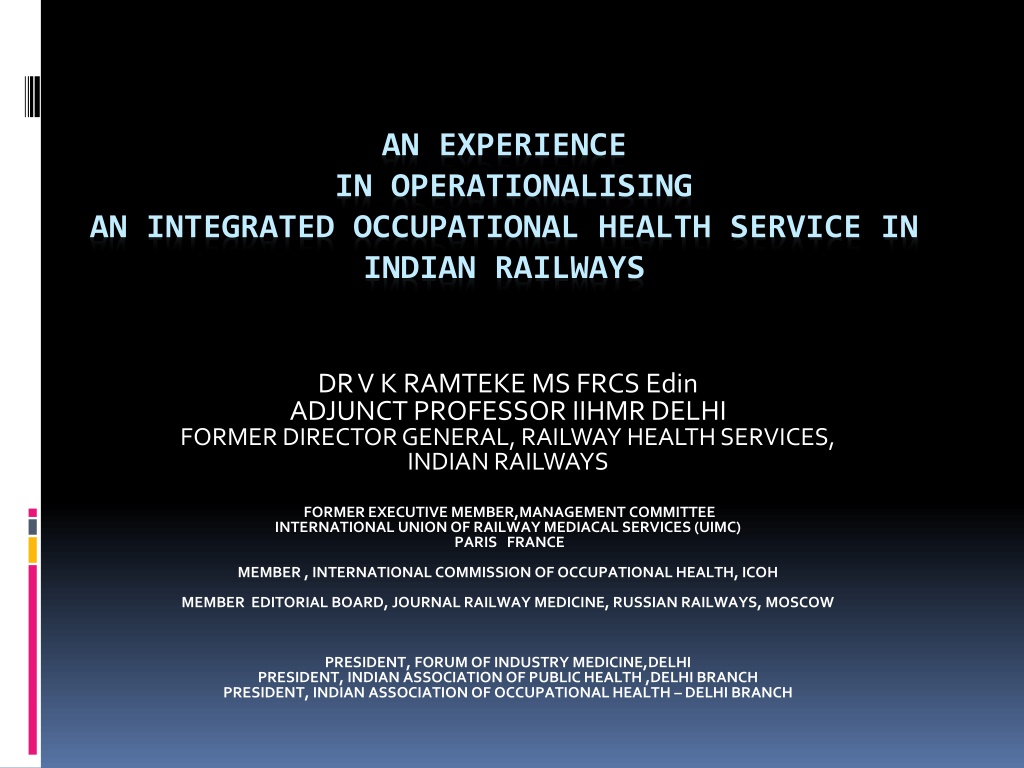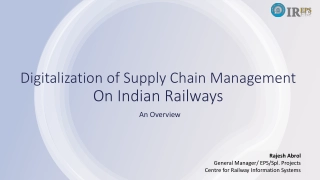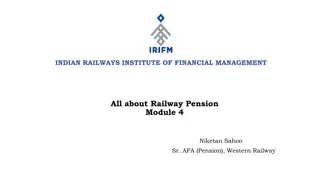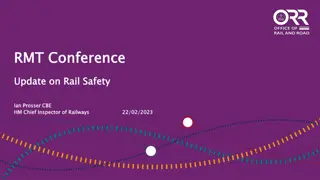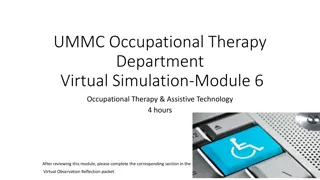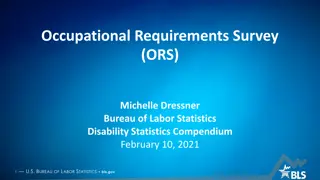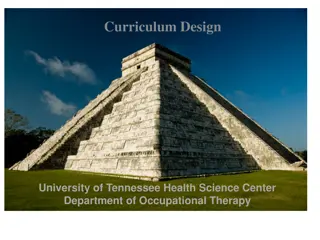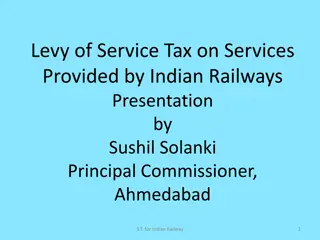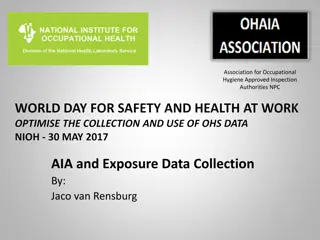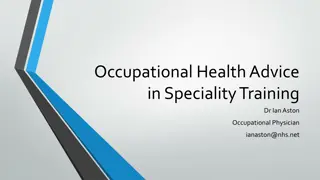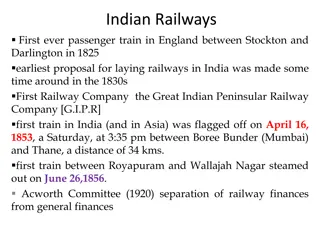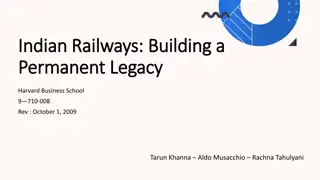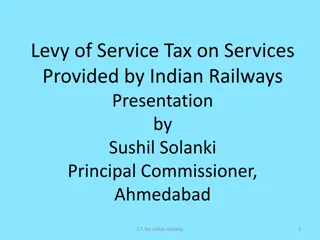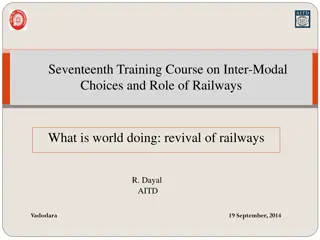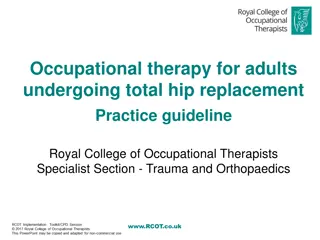Operationalising an Integrated Occupational Health Service in Indian Railways by Dr. V.K. Ramteke
Dr. V.K. Ramteke, a renowned expert in occupational health, shares his experience in operationalising an integrated occupational health service within Indian Railways. The service aims to address the specific health needs of the working population and involves various components such as curative, preventive, and administrative health services. The importance of collaboration between occupational health providers, policy makers, and other healthcare entities is emphasized for the successful implementation of such services. Dr. Ramteke's insights highlight the significance of integrating health services to ensure the well-being of railway employees and the community at large.
Download Presentation

Please find below an Image/Link to download the presentation.
The content on the website is provided AS IS for your information and personal use only. It may not be sold, licensed, or shared on other websites without obtaining consent from the author. Download presentation by click this link. If you encounter any issues during the download, it is possible that the publisher has removed the file from their server.
E N D
Presentation Transcript
AN EXPERIENCE IN OPERATIONALISING AN INTEGRATED OCCUPATIONAL HEALTH SERVICE IN INDIAN RAILWAYS DR V K RAMTEKE MS FRCS Edin ADJUNCT PROFESSOR IIHMR DELHI FORMER DIRECTOR GENERAL, RAILWAY HEALTH SERVICES, INDIAN RAILWAYS FORMER EXECUTIVE MEMBER,MANAGEMENT COMMITTEE INTERNATIONAL UNION OF RAILWAY MEDIACAL SERVICES (UIMC) PARIS FRANCE MEMBER , INTERNATIONAL COMMISSION OF OCCUPATIONAL HEALTH, ICOH MEMBER EDITORIAL BOARD, JOURNAL RAILWAY MEDICINE, RUSSIAN RAILWAYS, MOSCOW PRESIDENT, FORUM OF INDUSTRY MEDICINE,DELHI PRESIDENT, INDIAN ASSOCIATION OF PUBLIC HEALTH ,DELHI BRANCH PRESIDENT, INDIAN ASSOCIATION OF OCCUPATIONAL HEALTH DELHI BRANCH
Workers health: global plan of action Sixtieth World Health Assembly SIXTIETH WORLD HEALTH ASSEMBLY WHA60.26,Agenda item 12.13, 23 May 2007. In its introduction mentions ..... Allcomponents of health systems should be involved in an integrated response to the specific health needs of working populations. OCCUCON-DELHI 2012
OCCUPATIONAL HEALTH PROVIDER CURATIVE HEALTH PROVIDER PREV. AND PROMOTIVE HEALTH PROVIDER POLICY MAKERS I INTEGRATION OF HEALTH SERVICES OCCUCON-DELHI 2012
OCCUPATIONAL HEALTH SERVICES CURATIVE HEALTH SERVICES RAILWAY HEALTH SERVICES PREVENTIVE AND PROMOTIVE HEALTH SERVICES ADMINISTRATIVE SERVICES OCCUCON- DELHI 2012
Can Med Assoc J. 1964 Dec 19;91:1307-9. THE PHYSICIAN AND INDUSTRY. NELSON AJ. Many employers are interested in helping their employees improve and maintain health through a program of preventive medicine designed to supplement health services which already exist in the community. The objectives of such a health program can be attained only through team work between physicians, both within and outside industry. Such specific objectives as the development of measures for the maintenance and improvement of health and the prevention of disease; the provision of readily available diagnostic, treatment and counselling services; the rehabilitation of disabled employees; and the effective administration of sick-benefit plans require the closest communication and co-operation among the occupational health service, the private physician, and other health and welfare agencies. Only by such liaison can the maximum benefits of both preventive and curative medicine be extended to the employee-in his best interest as well as that of the community and the employer. OCCUCON- DELHI 2012
J Occup Med. 1992 Sep;34(9):893-901. Workers' attitude toward the occupational physician. Plomp HN. Institute of Social Medicine, Vrije Universiteit, Amsterdam, The Netherlands. We conclude that workers see clear differences in the tasks and functions of the occupational physician compared with those of the curative physician. Relations with and dependence on management is considered to be self-evident. A negative evaluation of the OHS is mainly because of unclarity and uncertainty as to how the occupational physician combines his/her responsibility toward individual workers with his/her responsibility toward the company. OCCUCON- DELHI 2012
INDIAN RAILWAYS AT A GLANCE : INDIAN RAILWAYS IS ONE OF THE LARGEST RAIL NETWORKS IN THE WORLD Number of Employees : 1.36 million Route length : 63,974 Kms. Total Track Kms. : 113,617 Kms Railway Stations : 7,030 Passenger Kms. : 903 billion Freight Train Kms : 356 million Passenger Originating : 7,246 million OCCUCON- DELHI 2012
No. of Zones : 17 No. of Divisions : 68 No. of Production Units : 6 Public Sector Undertakings: CONCOR, CRIS, IRCON, IRCTC, IRFC, KRCL, MRVC, RVNL, RCIL, RITES, DFCCIL, RLDA OCCUCON- DELHI 2012
MEDICAL DEPARTMENT HEALTH SERVICES INFRASTRUCTURE: Total No. of Railway Hospitals : 125 Total No. of Health Units : 586 Total No. of Indoor beds : 14,000 MANPOWER AVAILABLE: (a) Doctors- including Dental (b) Other doctors honorary visiting specialist, Sr. Residents, DNB trainees & house officers = 2,506 = 1.000 (c) Para Medical & other staff = 54.000 (d) Health Inspectors = 952 OCCUCON- DELHI 2012
Expenditure on Health Care Delivery System Year Expenditure (figures in millions of INR) 09-10 ( Actual) 13,782 10-11 (Revised estimate) 14,213 11-12 (BE) 15,934 (238 m Euros ) OCCUCON- DELHI 2012
Health Care Delivery OPD Attendance(Annual) Indoor patients(Annual) : 4.84 million : 26.47 million Annual Surgical operations(Annual) : 100,000 Major Surgical Operations(Annual) 44,229 Maydays lost on account of sickness(Annual) : 1.74% Medical examination of Employees(Annual) : 132,800 Medical examination of Candidates for Employment (Annual) : 35,103 OCCUCON- DELHI 2012
TOTAL NUMBER OF BENEFICIARIES : 1. Total Number of Railway Employees : 1.36 million 2. Total Number of Retired Railway Employees : 0.34 million Total beneficiaries: 1.36 million x 4 = 5.44 million 0.34 million x 2 = 0.68 million T OTAL = 6.12 million OCCUCON- DELHI 2012
INDIAN RAILWAYS Official Member of UIC (International Union of Railways) and UIMC (International Union of Railway Medical Services). Largest Employer (More than 1.36 million full-time regular employees) under Single Management in the World Largest Integrated Occupational Health Service under Single Management in the World. OCCUCON- DELHI 2012
STAKE HOLDERS A SEAMLESS INTEGRATION THE INDIAN RAILWAYS TO INCREASE PRODUCTIVITY, HAVE MOTIVATED EMPLOYEE AS THEY ARE SKILLED AND EXPENSIVE,EMP.WELFARE EMPLOYEE- HEALTHY ENVRON TO KEEP HIM HEALTHY AND FIT CURATIVE HEALTH PROVIDER- EARLY TREATMENT,ALL EFFORT TO MAKE HIM FIT FOR ORIGINAL JOB,COUNSELLING OCCUPATIONAL HEALTH PROVIDER - KEEP HIGHLY SKILLED EMP FIT FOR JOB,REDUCE MANDAYS LOSS,AWARENESS AND PREVENTIVE PROG.. TRADE UNIONS-EMP.WELFARE,AWARENESS PROG.,HELP IR TO MEET CORPORATE GOALS VARIOUS LEGISLATIONS E.G. FACTORY ACT, WORKMAN S COMPENSATION ACT ETC. OCCUCON- DELHI 2012
INTEGRATION - OCCUPATIONAL CATEGORY : FITNESS IN HIGH SAFETY ENDANGERS PASSENGERS AND PUBLIC MEDIUM SAFETY ENDANGERS COLLEAGUES AND SELF LOW SAFETY- THE REST MEDICAL EXAMINATION: PRE-PANEL MED.EXAM. PRE-EMPLOYMENT MED.EXAM. PERIODICAL MEDICAL EXAMINATION OCCUCON- DELHI 2012
INTEGRATION - PREVENTIVE AND PROMOTIVE HEALTH INSPECTORS & HEALTH OFFICERS SUPERVISE DRINKING WATER QUALITY FOOD QUALITY SANITATION HEALTH AWARENESS CAMPS HEALTH CHECKUP CAMPS IMMUNISATIONS HEPATITIS B, ETC DIETIC SERVICES PROMOTE HEALTHY LIFE STYLES OCCUCON- DELHI 2012
INTEGRATION - CURATIVE - HOSPITALS AND DISPENSARIES PRIMARY, SECONDARY, AND TERTIARY CARE -HUB AND SPOKE MODEL -FOR EMERGENCIES- EMPANELLED HOSPITALS OCCUCON-DELHI 2012
INTEGRATION - ADMINISTRATIVE -RLY. HEALTH BUDGET FOR INTEGRATED HEALTH SERVICES -SEPERATE CAPITAL INVESTMENT ON INFRA. AND EQUIP. -RAILWAY BOARD ON STAFF WELFARE HAS A SECY. LEVEL MEMBER STAFF AND DGRHS -TRADE UNIONS :PNM, SAFETY CAMPS, HOSP. VISITING COMMITTEE,OPINION ON STAFF WELFARE MATTERS,CONDUCT HEALTH AWARENESS PROG.BLOOD DONATION CAMPS - PARTICIPATION OF RAILWAY EMPLOYEES IN MANAGEMENT - PREM -POLICY ON LONG SICKNESS -MANDAY LOSS MONITORING -MORBIDITY AND MORTALITY MEETINGS -MONTHLY PERFORMANCE REPORT -QUATERLY CMDS MEETINGS OCCUCON- DELHI 2012
INTEGRATION ADMINISTRATIVE Railway Minister's, GM S, and CMD S Annual awards for Best Performance at Zonal, Divisional and Dispensary level respectively and Individual Awards for BEST WORKERS Ministry of Railways Approval for 90% reimbursement of Membership Fees of Indian Association of Occupational Health(IAOH) in Oct. 2009 to all Medical Officers . Ministry of Railways Approval for 90% reimbursement of Membership Fees of International Commission on Occupational Health(ICOH) in 2010 to all Medical Officers. OCCUCON- DELHI 2012
PARTNERSHIPS ILO, UIC,ITF Global Toolkit on HIV/AIDS for the Railway Sector validated on Indian Railways with partnership of Indian Railways Trade Unions and Indian Railways Health Care System in Nov 2009. 13 Scientific Papers by Medical Officers of Indian Railways in the 60th Annual National Conference of Indian Association of Occupational Health(IAOH) in Feb. 2010. President and Vice President of IAOH, Delhi State from Indian Railways Elected in Sept 2010. 18 Scientific Papers by Medical Officers of Indian Railways in the 61st Annual National Conference of Indian Association of Occupational Health(IAOH) in Feb. 2011. OCCUCON- DELHI 2012
Areas for Collecting Scientific Evidence Epidemiology of Work place injury Epidemiology of Occupational Dermatitis Prevalence of Non-communicable diseases HIV in work place Occupational Health and safety Awareness Workload Analysis of Medical Officers Epidemiology of Occupational Visual Disorders OCCUCON- DELHI 2012
Areas for Collecting Scientific Evidence Occupational stress amongst Operational staff and Railway Engine Pilots Sickness Absenteeism amongst Railway Employees Mortality pattern amongst serving employees Hypertension in loco pilots Ambient Air Quality, Respiratory symptoms and Lungs function of employees Musculoskeletal disorders amongst Health care Workers of a Hospital Epidemiology of Lifestyle associated individual disease components Sickness Absenteeism and morbidity pattern among the employees Epidemiology of Noise induced Hearing loss Medical Invalidation And Decategorisation on Medical Grounds OCCUCON- DELHI 2012
We have been able to achieve at Primary Health Care level: Railways India Crude Birth Rate 9.82 per 1000 22 Infant Mortality Rate 13.76 per 1000 live birth 48.2 Crude Death Rate 1.35 per 1000 mid-year population 6.4 OCCUCON- DELHI 2012
MANDAY LOSS DUE TO ILLNESS 2007-08 2008-09 2009-10 2010-11 MANDAY LOSS - RMC 8229923 7865733 7787001 7557708 MANDAY LOSS PER WORKER-RMC 5.8 5.5 5.5 5.4 MANDAY LOSS -IOD 569827 542131 516279 509295 MANDAY LOSS PER WORKER- IOD 0.39 0.39 0.36 0.36 MANDAYS LOSS PER WORKER PER YEAR RMC+IOD 6.19 5.90 6.40 5.76 OCCUCON- DELHI 2012
IMPACT OF PREVENTIVE HEALTH CARE ON INDIAN INDUSTRY AND ECONOMY Dr. Alka Chadha National University of Singapore September 12, 2007 New Delhi Preventive Health Care Seminar OCCUCON- DELHI 2012 25
Man days lost owing to sickness More than 51 24% 0-10 42% 31-50 11% 11-30 23% Preventive Health Care Seminar OCCUCON- DELHI 2012 26
Sickness Absenteeism, Morbidity and Workplace Injuries among Iron and Steel workers - A Cross Sectional Study from Karnataka, Southern In Publication: Australasian Medical Journal (Online) Author: Manjunatha, R Date published: February 22, 2011 Overall 16.4 days were lost per worker per year (male = 16.5 & female = 16.2) due to sickness absence. A blue collar worker lost 21.5 days compared to 11.9 days by a white collar worker (p < 0.01). Sickness absenteeism is significantly higher among iron and steel workers when compared to other occupations in India OCCUCON- DELHI 2012
Chartered Institute of Personnel and development cipd.co.uk ABSENCE MANAGEMENT Annual survey report 2010 RATES of Employee Absence The average level of employee absence at 3.4% of working time or 7.7 days per employee per year ha s increased slightly compared with last year s 3.3% or 7.4 days, when the CIPD s Absence Management survey recorded its lowest ever level of employee absence. However, it remains low in comparison with previous years (2008: 3.5% or 8.0 days; 2007: 3.7% or 8.4 days). OCCUCON- DELHI 2012
MANDAY LOSS DUE TO ILLNESS 2007-08 2008-09 2009-10 2010-11 MANDAY LOSS - RMC 8229923 7865733 7787001 7557708 MANDAY LOSS PER WORKER-RMC 5.8 5.5 5.5 5.4 MANDAY LOSS -IOD 569827 542131 516279 509295 MANDAY LOSS PER WORKER- IOD 0.39 0.39 0.36 0.36 MANDAYS LOSS PER WORKER PER YEAR RMC+IOD 6.19 5.90 6.40 5.76 OCCUCON- DELHI 2012
WORK DAY LOSS IN INJURY Incidence rates of lost-workday injury cases by private industry sector, 1976 2001.* May 04 Centers for Disease Control and Prevention, USA YEAR PVT CONST/MANU TRANS/PUB UTILITY 1997 3.1 4.2 4.7 1998 2.9 4.2 4.2 1999 2.8 4.0 4.3 2000 2.8 4.0 4.1 2001 2.6 3.6 4.2 OCCUCON- DELHI 2012
PME - UNFIT ON INDIAN RAILWAYS (Period of study April 2009 to March 2010) Total No. of Railway employees 1400000 Total No. UNFIT in one year 2724 % UNFIT -- 0.19 Total No. of Railway employees in HIGH SAFETY category A1 65141 Total No. of UNFIT in one yr 400 % UNFIT - 0.61% 31 OCCUCON- DELHI 2012
SWISS RAILWAYS 2011 -periodic examinations : Total of all examinations (all clients), of that part fit, limited fit and unfit 3.65% ARE UNFIT OF TOTAL PME 2'635 3'000 2'565 2'500 2'000 1'547 1'500 1'048 1'000 592 545 Performance level 1 295 250 500 Performance level 2 70 47 0 of which fit Total examinations of which unfit of whitch limited fit or fit of whitch limited fit 32 OCCUCON- DELHI 2012 CFF HR-AGS-AED MedicalService 23.08.2011
UNFIT FOR ALL JOBS DUE TO ILLNESS- WESTERN RAILWAYS 2000- 2002 YEAR TOTAL RLY EMPLOYEES EMPLOYEES UNFIT FOR ALL JOBS UNFIT FOR ALL JOBS PER 10,000 EMP. 2000 183716 69 3.75 2001 182916 76 4.15 2002 182815 81 4.43 OCCUCON- DELHI 2012
UNFIT FOR ALL JOBS DUE TO ILLNESS- INDIAN RAILWAYS 2005-2007 YEAR TOTAL RLY EMPLOYEES EMPLOYEES UNFIT FOR ALL JOBS UNFIT FOR ALL JOBS PER 10,000 EMP. 2005 1308780 763 5.80 2006 1300700 745 5.72 2007 1200423 727 6.00 OCCUCON- DELHI 2012
PRIMARY CAUSES FOR UNFIT FOR ALL JOBS DUE TO ILLNESS SR NO. PRIMARY CAUSE % OF TOTAL UNFIT 2000-02 % OF TOTAL UNFIT 2005-7 1 HYPERTENSION 23.4 48.5 2 TUBERCULOSIS 10.18 3.2 3 INJURY 7.96 7 4 DM 6.19 39 5 ALCOHOL 5 8 OCCUCON- DELHI 2012
REASONS FOR UNFITNESS S.NO. DISEASE % OF TOTAL CASES 2000-02 % OF TOTAL CASES 2005-7 1 TUBERCULOSIS 10.18 3.2 2 CVA-STROKE 33.6 38.6 3 OTHER CNS 12.39 19.03 4 EYE 11.50 9.82 5 INJURY 7.96 6.6 6 CANCER 10.1 4.5 7 RENAL 3.10 1.85 8 CVS 1.77 2.20 OCCUCON- DELHI 2012
INJURED ON DUTY SNO, 2008 2009 2010 WORKSHOP 1 NO OF EMP 274764 250026 238177 2 FATAL per 1000 0.58 0.15 0.19 3 GRIEV. Per 1000 6.6 4.7 4.6 4 SIMPLE per 1000 54.1 74.0 16.9 TRAIN OPT 1 NO OF EMP 925657 1029309 1151593 2 FATAL per 1000 0.20 0.20 0.11 3 GRIEV. per 1000 2.66 4.64 2.02 4 SIMPLE per 1000 25.9 25.6 8.8 OCCUCON- DELHI 2012
National Commission on Macroeconomics and Health (NCMH), NCMH Background Papers- Burden of Disease in India,National Commission on Macroeconomics and Health Ministry of Health & Family Welfare, Government of India, New Delhi September 2005, -Gururaj In India, It is estimated that 19 fatal and 1930 (1:100) non- fatal accidents occur annually per100,000 workers (Nag and Patel 1998). The incidence of industrial injuries among employed workers was 9/1000,with a frequency of 2.6 per 100,000 man-days work (CSO2004). As per the NCRB report of 2001, 667 people were killed in factory/machine accidents. OCCUCON- DELHI 2012
A limited number of population-based epidemiological studies reveal that occupational injuries constitute approximately 10% of total deaths due to injuries and 20% 25% of all injuries. Mohan (1992) in a study of industrial workers reported a death rate of 6/1000 workers. Varghese et al. (1990), in a cohort of 25,000 people from 9 villages of Haryana, observed the incidence rate of work-related injuries to be 31% over a one-year period. OCCUCON- DELHI 2012
Workers health: global plan of action Sixtieth World Health Assembly SIXTIETH WORLD HEALTH ASSEMBLY WHA60.26,Agenda item 12.13, 23 May 2007. In the preamble mentions .. Considering that the health of workers is determined not only by occupational hazards, but also by social and individual factors, and access to health services; OCCUCON- DELHI 2012
Workers health: global plan of action Sixtieth World Health Assembly Urges Member States: (5) to ensure collaboration and concerted action by all national health programmes relevant to workers 'health, such as those dealing with prevention of occupational diseases and injuries, communicable and chronic diseases, health promotion, mental health, environmental health, and health systems development; OCCUCON- DELHI 2012
Ned Tijdschr Geneeskd. 2011;155(48):A3880. [Patients on the collaboration between occupational and curative physicians]. [Article in Dutch] Plomp HN, Wisse A, Anema JK. Source VU Medisch Centrum, afd. Sociale Geneeskunde, Amsterdam, the Netherlands. hn.plomp@vumc.nl CONCLUSION: A physician's predominant perspective of the cooperation between occupational and curative physicians is a clinical one; the emphasis being on the establishment of adequate diagnoses and their treatments. Patients, however, view the cooperation between their occupational and curative physicians from a strategic perspective in which their own interests are the key decisive factors. In daily practice, this might explain the reason behind patients being more reserved about occupational-curative cooperation, in comparison with physicians. It is advisable that patients not only be asked their consent, but that they are also granted a consciously active role in the collaboration between their occupational and curative physicians as well as in their own occupational reintegration process. OCCUCON- DELHI 2012
NEWER TECH. AND OCCUPATIONAL HEALTH There is continuous review of fitness standards looking to newer technologies being introduced with better results. This helps to retain highly skilled and trained human resource which benefits both the organisation and the employee. Recent decisions taken on INDIAN RAILWAYS For loco drivers fit with DM and Tab. Metformin In high safety jobs including loco drivers- IOL allowed Tympanoplasty allowed Review is being done for fitness with cardiac ailments. OCCUCON- DELHI 2012
Directive Principles of State Policy The Directive Principles of State Policy of the Constitution of India provide for securing the health of employees in management of undertakings, establishments or other organizations engaged in any industry (Article 39, 42, 43A). On the basis of these Directive Principles and international instruments, the Government of India declares its policy, priorities, strategies and purposes. The Government is committed to regulate all economic activities within the country with a view to ensuring that every working employee is provided with safe and healthful working conditions.
OSH Occupational Safety and Health is one of the subjects allotted to Ministry of Labor & Employment under the Government of India Allocation of Business Rules. The Ministry of Labor & Employment, Govt. of India & Labor Departments of the States and Union Territories are responsible for the safety & health of the workers. Directorate General of Factory Advice Service & Labor Institutes (DGFASLI) and Directorate General of Mines Safety (DGMS) assist the Ministry in the technical aspects of Occupational Safety & Health in factories & port sectors and mines respectively.
Occupational Health and Safety legislation by and large covers the organized sector comprising just 7%, leaving behind the unorganized sector which comprises 93% of the total working population of around 470 million. The agriculture which is one of the biggest sector employing nearly 60% of the workforce in India is not covered by health and safety legislation.
With such a limited coverage of workforce and rather weak state of occupational health and safety, India may be having a GNP loss to the tune of several hundreds of billions of dollars every year. Serious efforts are needed to address this issue so as to prevent human and material losses. India may be experiencing almost 10% of GNP loss due to occupational illness and injuries.
The major occupational diseases/morbidity of concern in India are: silicosis, musculoskeletal injuries, coal workers pneumoconiosis, chronic obstructive lung diseases, asbestosis, byssinosis, pesticide poisoning and noise- induced hearing loss. Census figures (2011) have revealed that there is an increase of female workers leading to certain concerns, such as adverse effects on reproductive health, exposure to toxic chemicals in the workplace
In India, occupational health is not integrated with primary health care. Occupational Safety and Health till date remains under the mandate of the Ministry of Labor and not the Ministry of Health. Many large industries / public sector enterprises provide medical services but concentrate on curative set-up neglecting occupational health.
